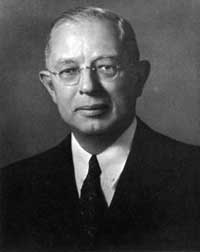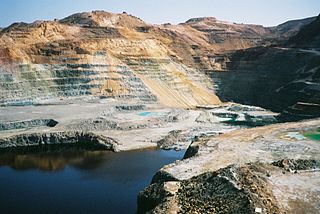
Copper extraction refers to the methods used to obtain copper from its ores. The conversion of copper ores consists of a series of physical, chemical and electrochemical processes. Methods have evolved and vary with country depending on the ore source, local environmental regulations, and other factors.

Codelco is a Chilean state-owned copper mining company. It was formed in 1976 from foreign-owned copper companies that were nationalised in 1971.

Kennecott Utah Copper LLC (KUC), a division of Rio Tinto Group, is a mining, smelting, and refining company. Its corporate headquarters are located in South Jordan, Utah. Kennecott operates the Bingham Canyon Mine, one of the largest open-pit copper mines in the world in Bingham Canyon, Salt Lake County, Utah. The company was first formed in 1898 as the Boston Consolidated Mining Company. The current corporation was formed in 1989. The mine and associated smelter produce 1% of the world's copper.

Newcrest Mining Limited is an Australian-based corporation which engages in the exploration, development, mining and sale of gold and the froth flotation product, gold-copper concentrate. It is Australia's leading gold mining company and its operations have expanded beyond Australia, for example Indonesia, thus becoming a prominent international mining corporation. Newmont initially started the company as a subsidiary in 1966. The subsidiary became Newmont Holdings Pvt Ltd in 1980 and in 1990 acquired 100 per cent of Australmin Holdings Limited taking the current name.

Harvey Seeley Mudd was a mining engineer and founder, investor, and president of Cyprus Mines Corporation, a Los Angeles–based international enterprise that operated copper mines on the island of Cyprus.

The Bingham Canyon Mine, more commonly known as Kennecott Copper Mine among locals, is an open-pit mining operation extracting a large porphyry copper deposit southwest of Salt Lake City, Utah, in the Oquirrh Mountains. The mine is the largest man-made excavation, and deepest open-pit mine in the world, which is considered to have produced more copper than any other mine in history – more than 19,000,000 short tons. The mine is owned by Rio Tinto Group, a British-Australian multinational corporation. The copper operations at Bingham Canyon Mine are managed through Kennecott Utah Copper Corporation which operates the mine, a concentrator plant, a smelter, and a refinery. The mine has been in production since 1906, and has resulted in the creation of a pit over 0.75 miles (1,210 m) deep, 2.5 miles (4 km) wide, and covering 1,900 acres. It was designated a National Historic Landmark in 1966 under the name Bingham Canyon Open Pit Copper Mine. The mine experienced a massive landslide in April 2013 and a smaller slide in September 2013.
Seeley Wintersmith Mudd (1861–1926) was an American mining engineer.
Mount Isa Mines Limited ("MIM") operates the Mount Isa copper, lead, zinc and silver mines near Mount Isa, Queensland, Australia as part of the Glencore group of companies. For a brief period in 1980, MIM was Australia's largest company. It has pioneered several significant mining industry innovations, including the Isa Process copper refining technology, the Isasmelt smelting technology, and the IsaMill fine grinding technology, and it also commercialized the Jameson Cell column flotation technology.

Southern Copper Corporation is a mining company that was founded in 1952. The current incarnation of Southern Copper can be traced to the 2005 acquisition of Southern Peru Copper Corporation by the Mexican copper producer Minera México.

The Toquepala mine is a large porphyry copper mine in the Tacna Province, Tacna Department, Peru. The mine is an open-pit mine producing copper, molybdenum, rhenium and silver with minor gold and zinc.

Thompson Creek Metals Company Inc. was a full cycle mining company with acquisition, exploration, development, and operation in North America. The corporate office was located in Denver, Colorado. The company primarily produced copper, gold, and molybdenum. Over its history, the Company evolved from being a major primary molybdenum producer to becoming a copper and gold mining company with the construction and development of the Mount Milligan mine and concentrator in British Columbia, Canada. Mount Milligan was Thompson Creek Metals principal operation and the company owned 100% of this property. The company also owned 100% of its Thompson Creek Mine in Idaho. Thompson Creek Metals owned 75% joint venture interest in two other properties, including its Endako Mine in British Columbia, and its Langeloth Metallurgical Facility (roaster) in Pennsylvania. Thompson Creek Metals had additional development projects, including the Berg property in British Columbia.

The ISASMELT process is an energy-efficient smelting process that was jointly developed from the 1970s to the 1990s by Mount Isa Mines and the Government of Australia's CSIRO. It has relatively low capital and operating costs for a smelting process.
Rosemont Copper is a proposed large open pit copper mine project by the Canadian mining corporation Hudbay Minerals. The project site is located within the Santa Rita Mountains and Coronado National Forest, in Pima County of southern Arizona. It has undergone a permitting review process under the direction of the United States Forest Service and the U.S. Army Corps of Engineers and has been delayed by legal judgements and suspension of its operating permit by the US Army Corps of Engineers.

The Sierrita Mine is a large copper mine located in the Sierrita Mountains of Arizona, in the southwestern part of the United States. The mine is located in southern Pima County, southwest of Tucson and west of Green Valley-Sahuarita.
Henry Thomas Mudd was an American heir, businessman and philanthropist. He served as chairman and chief executive officer of the Cyprus Mines Corporation. He also co-founded Harvey Mudd College in Claremont, California.
The Rhodesian Selection Trust (RST) was a mining Corporation which produced copper from the Copperbelt region of Northern Rhodesia, now Zambia.
Harold K. Hochschild was the president of the American Metal Company, a conservationist, a philanthropist, and the founder of the Adirondack Museum.

The mining industry of Cyprus is synonymous with copper extraction which began around 4,000 BC. Copper dominates the mining sector along with mining of iron pyrite, gold, chromites and asbestos fibers, bentonite, cement, and also petroleum. Though at one time, copper was a mainstay of the economy, as of 2012, the mining sector does not contribute in a significant way to the GNP.
American Metal Company was an American nonferrous metal trading and production company.

Cyprus Amax Minerals was a major US-based mining company formed in 1993 through the merger of AMAX with the Cyprus Minerals Company. It was one of the world's largest producers of Molybdenum and Lithium and was a leading producer of copper and coal. It also produced iron ore and gold. It was acquired by the Phelps Dodge Corporation in 1999.













